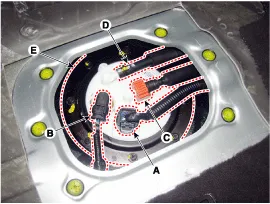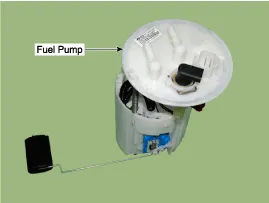Hyundai Genesis (DH): Fuel Delivery System / Fuel Pump Repair procedures
Hyundai Genesis (DH) 2013-2016 Service Manual / Engine Control / Fuel System / Fuel Delivery System / Fuel Pump Repair procedures
| Removal |
| 1. |
Release the residual pressure in fuel line.
(Refer to Fuel Delivery System - "Release Residual Pressure in Fuel Line") |
| 2. |
Fold the rear seat cushion. |
| 3. |
Remove the fuel pump service cover (A) at both the highest (H) and lowest (L) float level.
|
| 4. |
Disconnect the fuel pump connector (A) and fuel pressure connector (B). |
| 5. |
Disconnect the fuel feed tube quick-connector (C) and the suction hose (D). |
| 6. |
Remove the fuel pump plate cover (E) after loosening installation bolts, and then remove the fuel pump.
|
| Installation |
| 1. |
To install, reverse the removal procedure.
|
| Inspection |
| [Fuel sender] |
| 1. |
Turn ignition switch OFF and disconnect the negative (-)battery cable. |
| 2. |
Remove the fuel pump assembly.
(Refer to Fuel Delivery System - "Fuel Pump") |
| 3. |
Using an ohmmeter, measure the resistance between terminals 5 and 6 of sender connector (A) at each float level.
|
| 4. |
Check that the resistance is within the specification.
|






